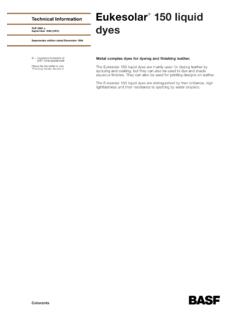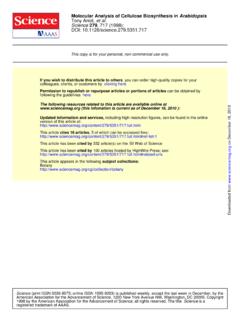Transcription of Technical Information BASF products for TI/T 344 …
1 Technical InformationTI/T 344 eJanuary 2000 (RV) = Registered trademark of basf AktiengesellschaftBASF products forresin finishingColorants and Finishing ProductsWITH TEXTILE CHEMICALSFROM BASFR esin Finishing1 General Information on finishingFinishing is generally the last stage of modern textile production. Its goal isto convert the bleached, dyed or printed fabric by mechanical and chemi-cal treatment into a suitable state for sale and making-up. There are threetypes of finishing process, mechanical, non-permanent and washfast,each of which usually involves the continuous treatment of woven or knit-ted fabrics in open-width form.
2 This leaflet focuses on the washfast finish-ing of woven and knitted fabrics composed of cotton, other cellulosic fibres, and their blends with synthetic fibres. The most important aspect ischemical finishing, also known as resin finishing, easycare finishing orwash-and-wear finishing. Resin finishing has been able to maintain itsposition in the finishing of textiles based on cellulosic fibres despitevarious disadvantages such as strength losses, shade changes, reducedwhiteness, and controversy about formaldehyde content. In fact, recentlythere has been a resurgence in its importance, because it allows textilefinishers to stand out from competitors by producing fabrics with enhan-ced agentsResin finishing is carried out with products known as crosslinking change woven and knitted fabrics composed of cellulosic fibres andtheir blends with synthetic fibres in such a way that the resulting textilesare easier to care essential component of the resin-finishing recipe is the catalyst.
3 Itallows the reaction to be carried out within the 130 180 C temperaturerange usually employed in the textile industry, and within the usual curingtimes (several minutes in the case of curing machines and several secondsin the case of stenters).The recipe for a resin-finishing liquor normally consists of: Crosslinking agent Catalyst Additives SurfactantsThe advantages of resin-finished over unfinished textiles, especially after washing, are: improved dimensional stability and shape retention less tendency to creasing easier to iron softer and smoother better appearance and therefore more durable less change in shade improved wet fastness of dyeings and prints less tendency to pilling, especially of fibre blends greater wash resistance of mechanically produced lustre andembossed finishes and finishes with softeners, stiffeningagents, water-repellents and oil-repellents3 AdditivesThe purpose of the additives is to offset partly or completely the adverseeffects of the crosslinking agent.
4 Thus softening and smoothing agents areapplied not only to improve the handle, but also to compensate as muchas possible for losses in tear strength and abrasion resistance. Other addi-tives serve to impart a particular character to the fabric. Examples arestiffening and filling agents, water-repellents, hydrophilizing agents, resin-finishing recipe contains surfactants as emulsifiers, wettingagents and stabilizers. These surface-active substances are necessary toensure that the fabric is wet rapidly and thoroughly during padding and tostabilize the recipe components and Information on crosslinking agentsThe first resin-finishing agents developed in the 1930s to improve thepoor wet strength of viscose staple fabrics were compounds of formal-dehyde and urea, though compounds of formaldehyde and melamine werelater also used.
5 In recent years the importance of this group of crosslinkingagents has declined because of the controversy about the high levels offree formaldehyde in the products and on the finished the appearance of easycare synthetic fibres in the 1950s, heterocy-clic crosslinking agents were developed to improve the competitivenessof cotton. Heterocyclic crosslinking agents are based on urea, formalde-hyde, and various other substances such as diamines and, in particular, the crosslinking agents that are formaldehyde-free, only products madefrom dimethyl urea and glyoxal have gained a small share of the formaldehyde-free crosslinkers have remained insignificant becauseof high toxicity, high manufacturing costs, inadequate wash resistance orpoor practically all effective resin-finishing agents are based on formalde-hyde, they have become part of the public debate about the toxicity of this substance.
6 This debate has strongly influenced and stimulated thedevelopment of crosslinking agents in recent years. New crosslinkers forlow-formaldehyde finishing and formaldehyde-free resins were the revival of resin finishing, processes that were almost forgotten,such as postcuring and moist crosslinking, are being applied agentsCrosslinking agents for formaldehyde-based resin finishing have the following general formula:They are divided into so-called self-crosslinking and reactant crosslink-ing agents. Self-crosslinking agents have a reactive hydrogen atom onthe nitrogen atom (R2 = H), whilst in reactant crosslinking agents the nitro-gen is part of a heterocyclic ring and therefore does not carry a reactivehydrogen.
7 Crosslinkers based on melamine represent a transition betweenself-crosslinking and reactant crosslinking agents. In basf s range of fin-ishing agents, the self-crosslinking agents are called Kaurit types andthe reactant crosslinking agents Fixapret typesThe Kaurit types are reaction products of urea and formaldehyde or mela-mine and formaldehyde. Some of these compounds are also methylatedwith methanol. They are used mainly for resin finishing textiles of regener-ated-cellulose fibres, and more generally for applying a stiffening suitable for this purpose are the N-methylol compounds ofurea, which impart a good swelling resistance to the fabric.
8 They alsoimprove the dimensional stability and crease recovery of regenerated-cel-lulose fabrics, giving them a high level of resilience. Chemical modification OCR1 NCH2 OHR245of these compounds and adaptation of the reaction conditions have allowed similar effects to be obtained on cotton and its typesThe Fixapret types are heterocyclic reaction products of urea, glyoxal andformaldehyde. Some of them are also modified with alcohols. Fixapret NF,which is formaldehyde-free, is exceptional in that it is a compound ofdimethyl urea and glyoxal. Among the formaldehyde-free crosslinkingagents, only those that are compounds of this type have achieved limitedsuccess in the resin-finishing market.
9 All the Fixapret types are suitable forresin finishing woven and knitted fabrics composed of cellulosic fibres andtheir blends with synthetic Fixapret types are reactant crosslinkers. Since, unlike self-crosslinkingagents, they have no reactive hydrogen atom on the nitrogen atom, theydo not tend to condense in the finishing liquor if this is left to stand for anextended period, even in the presence of a catalyst. It is mainly for thisreason that they produce a much softer fabric handle than self-crosslink-ing agents. The Fixapret types are very stable to hydrolysis both in the liquor and on the fabric, which means the liquors conform to the maximumworkplace concentration limits for formaldehyde even on long standing,and the easycare effects are resistant to repeated washing and dry cleaning, and to storage under tropical Fixapret range has been thoroughly overhauled over the last few new generation of Fixapret types produce finishes with an extremelylow level of free formaldehyde on the fabric.
10 These crosslinking agents arenevertheless very reactive even with magnesium chloride as the catalyst,making higher production speeds and lower production costs Fixapret types without exception contain only a very small amount ofchemically uncombined formaldehyde, so that if applied properly they allowthe legal limits on formaldehyde at the workplace and in the exhaust air tobe met. Those designed for low-formaldehyde finishing produce finisheswith a low to very low level of free formaldehyde on the goods. Naturally,formaldehyde-free Fixapret NF causes no problems with formaldehyde at all. Kaurit SKaurit S is a white, crystalline powder of dimethylol urea.








